Wednesday, August 26, 2015
Go ahead, end birthright American citizenship.
Currently, the United States grants citizenship automatically to every person born on our soil—including children of legal noncitizens, tourists, and even illegal immigrants. (Children of foreign diplomats are the exception.)
The U.S. has so-called birthright citizenship because the Constitution's 14th Amendment, ratified in 1868, says citizenship must be granted to "all persons born or naturalized in the United States, and subject to the jurisdiction thereof."
I argue that "subject to the jurisdiction thereof" does not include illegal immigrants, and I'm not alone. One of the Amendment's authors, Senator Jacob Howard of Michigan, said it "will not, of course, include persons born in the United States who are foreigners, aliens..."
Aside from any constitutional arguments, I believe giving citizenship based merely on where you are born is bad public policy. Citizenship is about more than that; it is about our proud history, common standards, and willingness to uphold these ideals.
What message does granting citizenship to the children of illegal immigrants send to people waiting to get into the U.S. legally? Foreigners who want to become citizens can wait as long as 18 years. Once someone crosses our borders illegally and gives birth to a child, their entire family is able to cut in line, degrading the legitimacy of our immigration system.
Almost no other country in the world offers birthright citizenship for these reasons. Lawbreakers should not be rewarded through the destructive policy of birthright citizenship.
Yep, deport any of the anchor babies.
Saturday, August 15, 2015
Wii U is like Sega Saturn or Sega CD
The Sega Saturn was released in 1995 in the US resulted in never released clever Japanese SHMUPS (DoDonPachi, Radiant Silvergun, Battle Garrega, Terra Driver, Batsugun), Dragon Force and Panzer Dragoon Saga (best games) were very pricey. Another reason Saturn died early was the 3D graphics were horrible. The Wii U does have a Legend of Zelda (Wind Waker HD), Super Mario Bros. (Super Mario 3D World) and Mario Kart (Mario Kart 8) compatible with the Wiimote and Nunchuck. Even though it comes packed with the gamepad, the Wiimote still is compatible with all the games. The Nintendo NX will be more powerful and hopefully will copy the Xbox 360 controller. I think only 25 games came out for Wii U so it looks a lot like Sega CD. I read articles that the new Legend of Zelda game would come out for Wii U and next generation 'Nintendo NX'.
The biggest budget game next year is Final Fantasy XV, as well as Uncharted 4 on ps4.
Thursday, August 13, 2015
New studies support the possibility of sea life on Enceladus
NASA’s Cassini spacecraft spotted geysers on the surface of Saturn’s moon Enceladus ten years ago. And new research suggests that these geysers are caused by active hydrothermal vents at the bottom of the moon’s ice-covered sea–vents that potentially warm the water to a temperature that could sustain life.
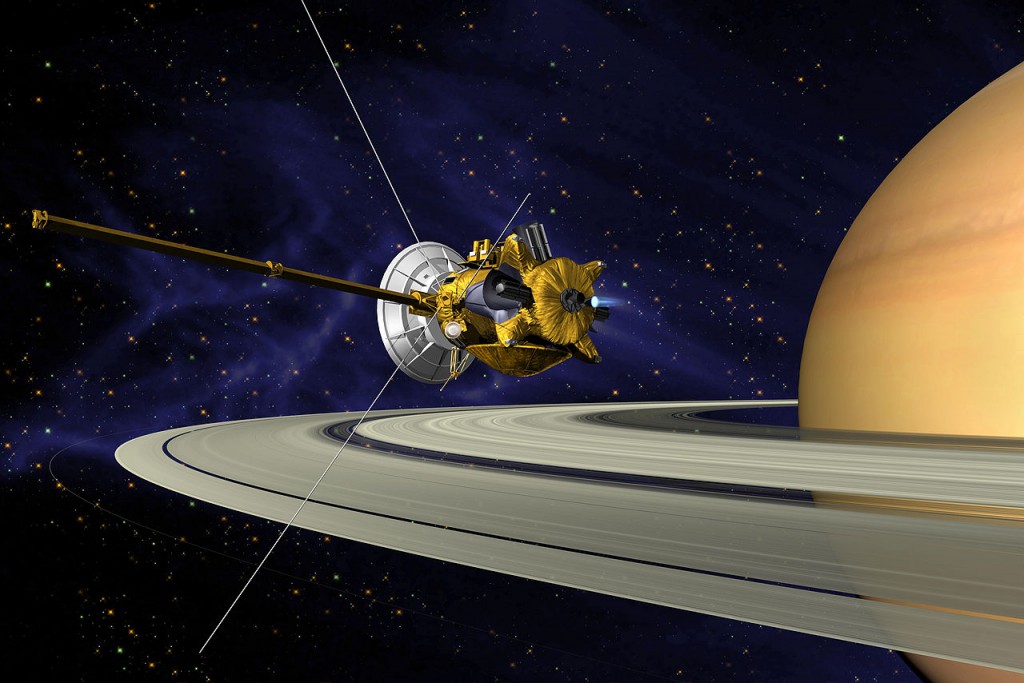
Artist’s impression of Cassini in orbit around Saturn. (Credit: NASA)
Although other processes could explain the geysers observed by Cassini, scientists believe Earthlike volcanic vents are the best explanation. And scientists note that this is the first time active hydrothermal vents have been seen outside of Earth’s seafloor.
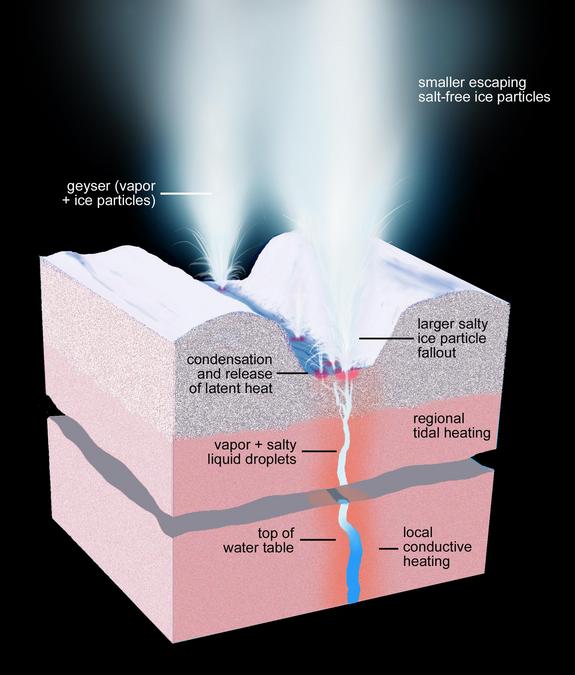
Illustration showing geysers on Enceladus. (Credit: NASA/JPL-Caltech/Space Science Institute)
Scientists are excited for future missions to Enceladus to better determine if the moon’s sea does, indeed, harbor life. Cassini will sample the moon’s water plumes again in October. But, unfortunately, the spacecraft doesn’t have the necessary instruments to detect life. And, it will likely be a while before any subsequent mission to Enceladus is realized. NASA’s priority is Jupiter’s moon Europa–another moon that may be home to extraterrestrial life.
Sunday, August 09, 2015
Linux Mint 17.2 review

92
1 Jul 2015 at 19:19,
Scott Gilbertson
Review The underlying packages in Linux Mint 17.2, just released, are largely unchanged. What you will
find are a lot of improvements and added polish in everyday tools like
the update manager, login screen and the Software Sources app.
Sticking with the Ubuntu 14.04 base has given Linux Mint developers the opportunity to focus their time and effort on the aspects of Mint that make it unique. Much of that focus has been on the project's two desktops, Cinnamon and MATE. Indeed it's the updates to both desktops that make Linux Mint 17.2 well worth the upgrade.
Mint seems to be one of the few distros to have taken
the idea of "if it ain't broke, don't fix it" to heart, with the result
that it’s fast becoming one of the most popular distros.
Part of the reason for that popularity lies in its excellent desktops, the stripped down, GNOME 2.x-inspired MATE, and the somewhat fancier – but still traditional – desktop, Cinnamon. Both of Mint's primary desktops stick with the traditional desktop paradigm – taskbar-like panels with applets, a start menu and system tray – making them popular with users not interested in "modern" desktops like Unity and GNOME Shell.
Both Cinnamon and MATE have seen major updates in Mint 17.2.
The Cinnamon version of Mint 17.2 ships with the brand-new Cinnamon 2.6 major update that builds on the previous release while adding improved support for dual monitors and better panels. It also sees some speed improvements that will make your desktop experience a bit snappier.
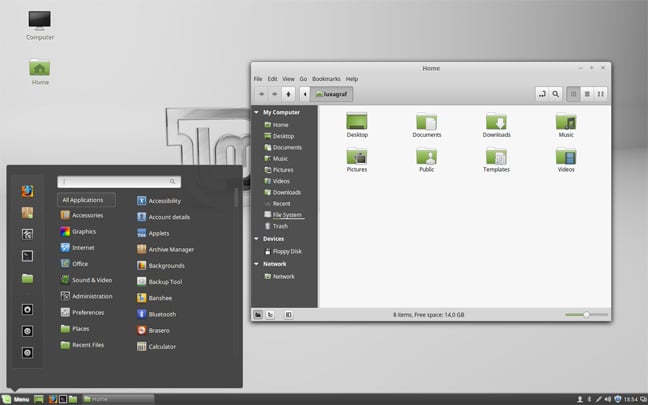 The Cinnamon 2.6 desktop in the new Mint
In recent months Cinnamon has proved something more
than just a Linux Mint desktop. It's now available in half a dozen
distros and, while Mint is still the only distro to use it by default,
Fedora and Debian have added Cinnamon to their installers. For a
complete look at everything that's new in Cinnamon 2.6, see my earlier review.
The Cinnamon 2.6 desktop in the new Mint
In recent months Cinnamon has proved something more
than just a Linux Mint desktop. It's now available in half a dozen
distros and, while Mint is still the only distro to use it by default,
Fedora and Debian have added Cinnamon to their installers. For a
complete look at everything that's new in Cinnamon 2.6, see my earlier review.
Cinnamon 2.6 in Mint 17.2 manages to offer a desktop experience that's both familiar and yet feels modern.
Linux Mint's other desktop, MATE, has also been the focus of numerous updates and improvements this time around. Mint 17.2 ships with MATE 1.10, which is notable for its speed and memory use improvements, most of which come out of a code analysis designed to track down and fix the problems. MATE has always been a lightweight, snappy desktop and I didn't notice much of a speed improvement, but it did use slightly less RAM in my tests.
Another nice change is a new audio library by the name of libmatemixer. You might not notice it overtly, but it does mean MATE can now take full advantage of mixer functionality and will automatically detect and support PulseAudio, ALSA and OSS.
MATE has a few other minor improvements, like the ability to enable or disable extensions in Caja (the default file manager in MATE) at runtime (no need to restart MATE for changes to take effect). The help and documentation tools are now available within the desktop and Linux Mint has started a "papercut" project for MATE designed to fix many small issues and port some of the Cinnamon new features into MATE. The results of that project should start to trickle in with point updates as the 17.2 release cycle progresses.
There are also some improvements in this release to Mint-specific tools that are used in both desktops, like the Update Manager and Login Screen.
Mint 17.2 continues to improve the already very nice, and surprisingly readable, Update Manager. This release adds support for package aliases, which means, for example, that a package like "muffin" can be displayed as "cinnamon-muffin" so it appears alongside other Cinnamon updates. This makes it easier to scan through your updates and see what's happening to various aspects of the system all in one spot. Even if you don't bother to read up on what "muffin" does, at least you know it's part of Cinnamon, and if the desktop suddenly starts acting wonky after an update you know where to start troubleshooting.
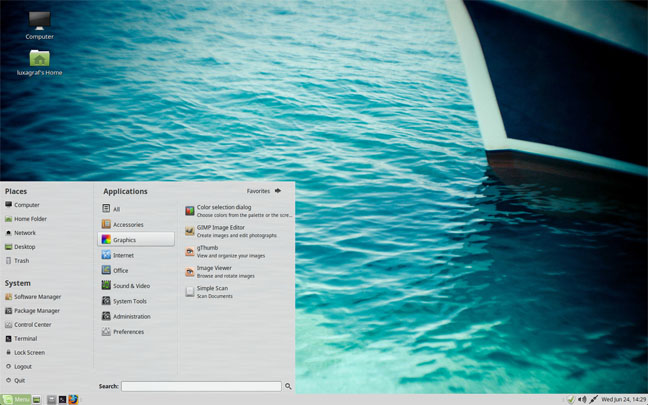 Linux Mint 17.2 MATE looks more like Cinnamon every day
There's also a new apt command available in this
release, "apt recommends", which will show you all the missing
recommended packages for a particular package. For example, if you want
to install Calibre, you'd type "apt recommends calibre" to see what else
you'll need to install.
Linux Mint 17.2 MATE looks more like Cinnamon every day
There's also a new apt command available in this
release, "apt recommends", which will show you all the missing
recommended packages for a particular package. For example, if you want
to install Calibre, you'd type "apt recommends calibre" to see what else
you'll need to install.
Another nice little change is the ability to hide the Update Manager system tray icon when no updates are available, if, perchance, this bothers you the way it did me.
The related Software Sources configuration tool has a new feature that lets you open PPA archives and browse their packages. You no longer need to switch to another tool to install what you were looking for.
Software Sources also now has a tool to list "foreign packages" and to downgrade them. What Mint refers to as a "foreign package" is a package where the origin or version is unknown and that doesn't match what is available in repositories known by your operation system. In other words you downloaded and installed something. It's now much easier to purge these packages from your system and to roll back to older versions. For example, if you enable Mint's testing repos to experiment with something and then change your mind, it's much easier to go back to what you had.
While the base package system remains Ubuntu 14.04, there are some application updates – LibreOffice 4.4.3 and Inkscape .91. For more on what's new in the Inkscape update, see my full Inkscape review. One thing you won't find here is systemd, though your reprieve is short-lived since that will be coming when Mint updates to 16.04 as a base next year.
 Among the changes in Cinnamon 2.6, you can now move the taskbar-style panel – or add another for each additional monitor
There are numerous minor improvements to tools like
the USB Writer, support for a larger number of HP printers, improved
bash command completion and some improvements to the login manager. And,
of course, Mint 17.2 features the usual slew of wallpaper updates.
Among the changes in Cinnamon 2.6, you can now move the taskbar-style panel – or add another for each additional monitor
There are numerous minor improvements to tools like
the USB Writer, support for a larger number of HP printers, improved
bash command completion and some improvements to the login manager. And,
of course, Mint 17.2 features the usual slew of wallpaper updates.
Mint has historically had a rocky upgrade process. It's almost always been easier to do a clean install of the system than to try to upgrade from, say, Mint 16 to 17. In Mint's defense, a clean install is always the safer way to upgrade a system – and another reason to have a separate partition for /home – but it did make upgrading a pain.
Thankfully this is not the case with Mint 17.2 because the underlying packages from Ubuntu have not changed. You can update to Mint 17.2 directly from Update Manager. That will continue to be true for the rest of the 17.x release cycle (which will last through Ubuntu 16.04, due in April 2016).
And indeed you should upgrade. Given that it's easy and painless to update, combined with all the improvements in this release, Linux Mint 17.2 is well worth it. This is exactly the kind of user-focused release that solves small, everyday problems while leaving the rest of the system alone. ®
Sticking with the Ubuntu 14.04 base has given Linux Mint developers the opportunity to focus their time and effort on the aspects of Mint that make it unique. Much of that focus has been on the project's two desktops, Cinnamon and MATE. Indeed it's the updates to both desktops that make Linux Mint 17.2 well worth the upgrade.
Part of the reason for that popularity lies in its excellent desktops, the stripped down, GNOME 2.x-inspired MATE, and the somewhat fancier – but still traditional – desktop, Cinnamon. Both of Mint's primary desktops stick with the traditional desktop paradigm – taskbar-like panels with applets, a start menu and system tray – making them popular with users not interested in "modern" desktops like Unity and GNOME Shell.
Both Cinnamon and MATE have seen major updates in Mint 17.2.
The Cinnamon version of Mint 17.2 ships with the brand-new Cinnamon 2.6 major update that builds on the previous release while adding improved support for dual monitors and better panels. It also sees some speed improvements that will make your desktop experience a bit snappier.
 The Cinnamon 2.6 desktop in the new Mint
The Cinnamon 2.6 desktop in the new MintCinnamon 2.6 in Mint 17.2 manages to offer a desktop experience that's both familiar and yet feels modern.
Linux Mint's other desktop, MATE, has also been the focus of numerous updates and improvements this time around. Mint 17.2 ships with MATE 1.10, which is notable for its speed and memory use improvements, most of which come out of a code analysis designed to track down and fix the problems. MATE has always been a lightweight, snappy desktop and I didn't notice much of a speed improvement, but it did use slightly less RAM in my tests.
Another nice change is a new audio library by the name of libmatemixer. You might not notice it overtly, but it does mean MATE can now take full advantage of mixer functionality and will automatically detect and support PulseAudio, ALSA and OSS.
MATE has a few other minor improvements, like the ability to enable or disable extensions in Caja (the default file manager in MATE) at runtime (no need to restart MATE for changes to take effect). The help and documentation tools are now available within the desktop and Linux Mint has started a "papercut" project for MATE designed to fix many small issues and port some of the Cinnamon new features into MATE. The results of that project should start to trickle in with point updates as the 17.2 release cycle progresses.
There are also some improvements in this release to Mint-specific tools that are used in both desktops, like the Update Manager and Login Screen.
Mint 17.2 continues to improve the already very nice, and surprisingly readable, Update Manager. This release adds support for package aliases, which means, for example, that a package like "muffin" can be displayed as "cinnamon-muffin" so it appears alongside other Cinnamon updates. This makes it easier to scan through your updates and see what's happening to various aspects of the system all in one spot. Even if you don't bother to read up on what "muffin" does, at least you know it's part of Cinnamon, and if the desktop suddenly starts acting wonky after an update you know where to start troubleshooting.
 Linux Mint 17.2 MATE looks more like Cinnamon every day
Linux Mint 17.2 MATE looks more like Cinnamon every dayAnother nice little change is the ability to hide the Update Manager system tray icon when no updates are available, if, perchance, this bothers you the way it did me.
The related Software Sources configuration tool has a new feature that lets you open PPA archives and browse their packages. You no longer need to switch to another tool to install what you were looking for.
Software Sources also now has a tool to list "foreign packages" and to downgrade them. What Mint refers to as a "foreign package" is a package where the origin or version is unknown and that doesn't match what is available in repositories known by your operation system. In other words you downloaded and installed something. It's now much easier to purge these packages from your system and to roll back to older versions. For example, if you enable Mint's testing repos to experiment with something and then change your mind, it's much easier to go back to what you had.
While the base package system remains Ubuntu 14.04, there are some application updates – LibreOffice 4.4.3 and Inkscape .91. For more on what's new in the Inkscape update, see my full Inkscape review. One thing you won't find here is systemd, though your reprieve is short-lived since that will be coming when Mint updates to 16.04 as a base next year.
 Among the changes in Cinnamon 2.6, you can now move the taskbar-style panel – or add another for each additional monitor
Among the changes in Cinnamon 2.6, you can now move the taskbar-style panel – or add another for each additional monitorMint has historically had a rocky upgrade process. It's almost always been easier to do a clean install of the system than to try to upgrade from, say, Mint 16 to 17. In Mint's defense, a clean install is always the safer way to upgrade a system – and another reason to have a separate partition for /home – but it did make upgrading a pain.
Thankfully this is not the case with Mint 17.2 because the underlying packages from Ubuntu have not changed. You can update to Mint 17.2 directly from Update Manager. That will continue to be true for the rest of the 17.x release cycle (which will last through Ubuntu 16.04, due in April 2016).
And indeed you should upgrade. Given that it's easy and painless to update, combined with all the improvements in this release, Linux Mint 17.2 is well worth it. This is exactly the kind of user-focused release that solves small, everyday problems while leaving the rest of the system alone. ®
Tuesday, August 04, 2015
unidentified radio bursts from space
Scientists analyzing radio bursts from space have discovered a
strange pattern that suggests the signals may be of an artificial
nature. Some scientists have been open to the idea that the radio
signals are a possible extraterrestrial beacon, and this new data does
not rule out that possibility.
In a paper posted on the Cornell University Library website, Michael Hippke of the Institute for Data Analysis in Neukirchen-Vluyn, Germany, and John Learned at the University of Hawaii in Manoa discovered that the dispersion measures of the signals are multiples of the number: 187.5.
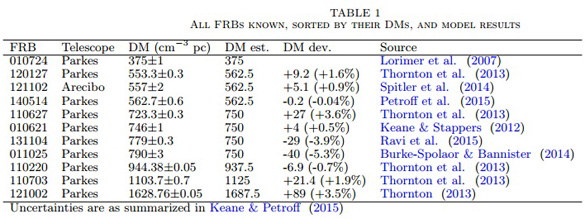
What does that mean? Well, from what I understand, scientist use the
dispersion measure to help them figure out how far a signal came from.
Higher frequencies travel faster than lower ones, so by measuring the
difference in time the frequencies of the signal are received- the
dispersion measure – they can get an idea of the distance traveled.
In this case, the dispersion measures seem to indicate an artificial origin. Hippke and Learned write: “We estimate the likelihood of a coincidence as 5:10,000.”
“If the pattern is real,” Learned told New Scientist, “it is very, very hard to explain.”
The signals in question are called fast radio bursts (FRBs), and have been recorded since 2001. Only one, in 2014, was detected real-time as it happened. The others were discovered by sifting through recorded data from telescopes. There have now been 11 FSBs recorded in total.
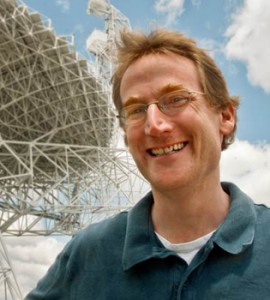
In a recent Huffington Post blog by Seth Shostak,
senior astronomer for the Search for Extraterrestrial Intelligence
(SETI) Institute, he explains that it was sifting through data from
telescopes that lead to the discovery of the FRBs in 2007. Shostak says
that Duncan Lorimer discovered the brief “flashes” of radio energy using
a telescope in Australia.
According to former director of the SETI Institute Jill Tarter, “beacon from extraterrestrials” has always been considered one of the weird possibilities for the origins of the FRBs.
Tarter told New Scientist, “These have been intriguing as an engineered signal, or evidence of extraterrestrial technology, since [they] first [were] discovered.”
In an FAQ on the signals posted on New Scientist, they point out that there are many possible natural origins of radio signals from space. However, they also note that the possible natural sources “don’t account for the fast radio bursts’ pattern according to any physics we know now.”
In the conclusion to their paper, Learned and Hippke write that if the natural sources are ruled out, “an artificial source (human or non-human) must be considered.”
Hippke tells the New Scientist, “there is something really interesting we need to understand. This will either be new physics, like a new kind of pulsar, or, in the end, if we can exclude everything else, an ET.”
“When you set out to search for something new,” he says, “you might find something unexpected.”
However, Shostak points out in his blog, there is one more thing we need to rule out before jumping on the ET band wagon. He writes, “In the case of the FRBs, one possible explanation — still not ruled out — is positively prosaic: They could be some type of man-made interference that only seems to be coming from deep space.”
The New Scientist article also speculates that there may still be terrestrial answers. They write, “It’s also possible that the telescopes are picking up evidence of human technology, like an unmapped spy satellite, masquerading as signals from deep space.”
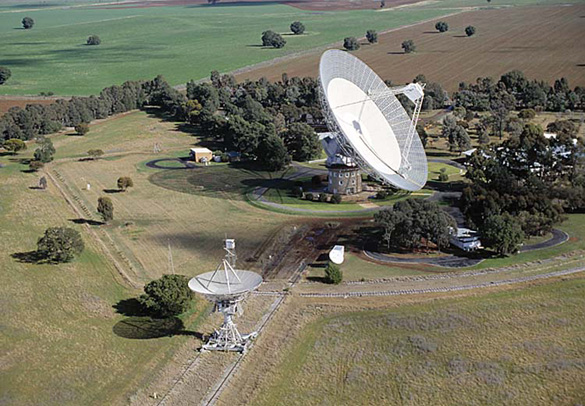
A recent update to the paper written by Hippke and Learned adds
research that provides further evidence that the FRBs may be of
terrestrial origin. The update was posted on March 30, and includes the
addition of Wilfried Domainko of the Max Planck Institute for Nuclear
Physics to the research team.
The update includes the discovery that the signals may arrive at times that align with UTC time. According to the paper, “the suggestive correlation with terrestrial time standards seems to nearly clinch the case for human association of these peculiar phenomena.”
So are the signals ET or human? It will take further research, and the discovery of more FRBs to verify. The new FRBs may or may not fit the dispersion measure patterns or align with UTC times. Perhaps some other feature to the FRBs will come to light giving scientists more information to go on.
Until more is discovered, we just don’t know.
The final sentence in the FRB research paper says, “In the end we only claim interesting features which further data will verify or refute.”
Meanwhile, Shostak warns, “It’s always tempting to invoke dramatic explanations for novel phenomena — after all, that makes them both more interesting and more important. But history suggests that caution is a good idea, and more likely to be justified in the end.”
In a paper posted on the Cornell University Library website, Michael Hippke of the Institute for Data Analysis in Neukirchen-Vluyn, Germany, and John Learned at the University of Hawaii in Manoa discovered that the dispersion measures of the signals are multiples of the number: 187.5.

Table
from the FRB paper showing information on their dispersion measures,
who found them, when and at which telescope. (Credit: Michael Hippke,
John Learned, and Wilfried Domainko)
In this case, the dispersion measures seem to indicate an artificial origin. Hippke and Learned write: “We estimate the likelihood of a coincidence as 5:10,000.”
“If the pattern is real,” Learned told New Scientist, “it is very, very hard to explain.”
The signals in question are called fast radio bursts (FRBs), and have been recorded since 2001. Only one, in 2014, was detected real-time as it happened. The others were discovered by sifting through recorded data from telescopes. There have now been 11 FSBs recorded in total.

Duncan Lorimer, Professor of Physics and Astronomy, West Virginia University. (Credit: West Virginia University)
According to former director of the SETI Institute Jill Tarter, “beacon from extraterrestrials” has always been considered one of the weird possibilities for the origins of the FRBs.
Tarter told New Scientist, “These have been intriguing as an engineered signal, or evidence of extraterrestrial technology, since [they] first [were] discovered.”
In an FAQ on the signals posted on New Scientist, they point out that there are many possible natural origins of radio signals from space. However, they also note that the possible natural sources “don’t account for the fast radio bursts’ pattern according to any physics we know now.”
In the conclusion to their paper, Learned and Hippke write that if the natural sources are ruled out, “an artificial source (human or non-human) must be considered.”
Hippke tells the New Scientist, “there is something really interesting we need to understand. This will either be new physics, like a new kind of pulsar, or, in the end, if we can exclude everything else, an ET.”
“When you set out to search for something new,” he says, “you might find something unexpected.”
However, Shostak points out in his blog, there is one more thing we need to rule out before jumping on the ET band wagon. He writes, “In the case of the FRBs, one possible explanation — still not ruled out — is positively prosaic: They could be some type of man-made interference that only seems to be coming from deep space.”
The New Scientist article also speculates that there may still be terrestrial answers. They write, “It’s also possible that the telescopes are picking up evidence of human technology, like an unmapped spy satellite, masquerading as signals from deep space.”

The Parkes radio telescope in Australia. All but one of the 11 FRB signals was recorded using this telescope.
The update includes the discovery that the signals may arrive at times that align with UTC time. According to the paper, “the suggestive correlation with terrestrial time standards seems to nearly clinch the case for human association of these peculiar phenomena.”
So are the signals ET or human? It will take further research, and the discovery of more FRBs to verify. The new FRBs may or may not fit the dispersion measure patterns or align with UTC times. Perhaps some other feature to the FRBs will come to light giving scientists more information to go on.
Until more is discovered, we just don’t know.
The final sentence in the FRB research paper says, “In the end we only claim interesting features which further data will verify or refute.”
Meanwhile, Shostak warns, “It’s always tempting to invoke dramatic explanations for novel phenomena — after all, that makes them both more interesting and more important. But history suggests that caution is a good idea, and more likely to be justified in the end.”
Subscribe to:
Comments
(
Atom
)